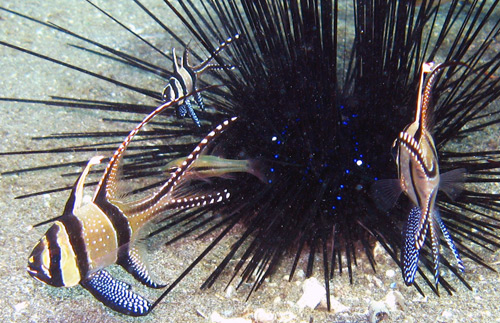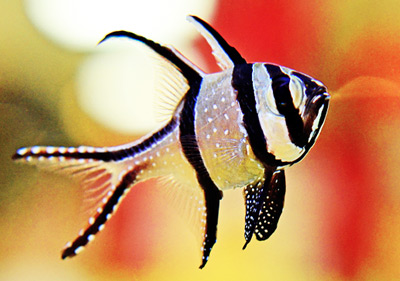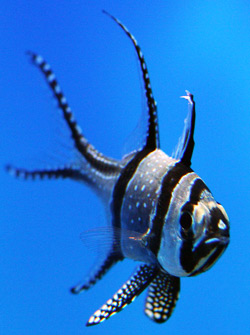Being fascinating to behold, very hardy and adaptable to aquarium fare, an exceptional choice for reef systems, suitable for modest-sized aquariums, and even easy to breed in captivity, the Banggai, or Kaudern’s, cardinalfish (Pterapogon kauderni) is a lot like Mary Poppins—practically perfect in every way.
Physical traits
P. kauderni is silver overall with tiny white polka dots and three prominent, vertical black bands, with one passing through the rather prominent eye, another anterior to the pelvic fins, and a third anterior to the caudal peduncle. The first dorsal fin is black with a white trailing edge, and the other fins are black with white dots. The tail is deeply forked. Glimpse its coloration and patterning, and it’s easy to see how this cardinal can readily conceal itself against or among the long spines of the Diadema sp. sea urchins with which it’s known to associate in nature. Maximum length for this species is right around 3 inches.
Feeding
The Banggai’s natural diet consists of small benthic and planktonic crustaceans, and it will accept a wide variety of small, meaty foods in captivity, such as mysid shrimp, enriched brine shrimp, plankton, bloodworms, and chopped crustacean and mollusk flesh. Reef Frenzy® Nano would be a great option as a staple offering for this species.

Housing
Being small and not especially demanding when it comes to swimming space, Banggais are well suited to systems as small as 30 gallons. Like all cardinals, they are nocturnal by nature, so it’s a good idea to provide lots of caves and ledges in/under which they can hide. Don’t worry, though. Most specimens will adapt to daytime feeding, so you should still be able to view your Banggai in daylight.
Compatibility
P. kauderni will coexist with most other small, peaceful species. However, it’s best to avoid keeping Banggais in groups unless you have a very large aquarium. Otherwise, serious hierarchical squabbling will likely persist until only the strongest individual remains. Known mated pairs may be an exception to the one-to-a-tank rule as well.
As alluded in the opening paragraph, P. kauderni is an exemplary candidate for reef systems, being completely inoffensive to sessile invertebrates.
Buy only captive-bred Banggais!
Okay, now we come to the one very important caveat to consider before buying Banggais—wild-caught specimens must be avoided! The reason being, P. kauderni has a very limited range in the Western Pacific. Fishbase describes its range as “Apparently restricted to Banggai Islands, Indonesia. Also found in several small islands off nearby eastern Taliabu Island and Luwuk vicinity.”
Because its natural range is so narrow, P. kauderni is threatened with extinction due to overcollection for the aquarium trade. That’s the bad news. The good news is, because P. kauderni is a mouthbrooding species with no planktonic larval stage, it is among the easiest marine species to breed in captivity and captive-bred specimens are routinely available in the trade for a very reasonable price. Be sure to buy them instead!




